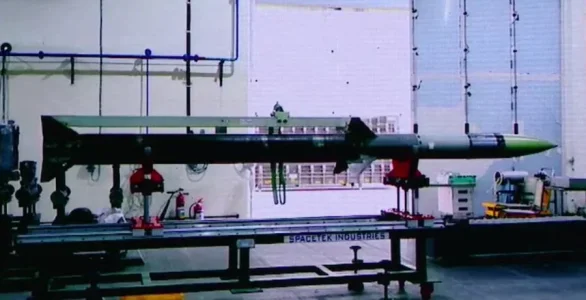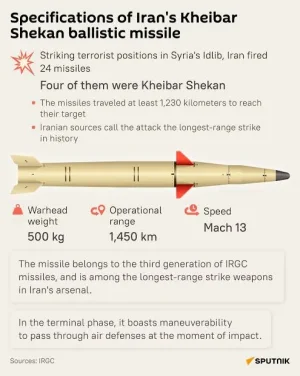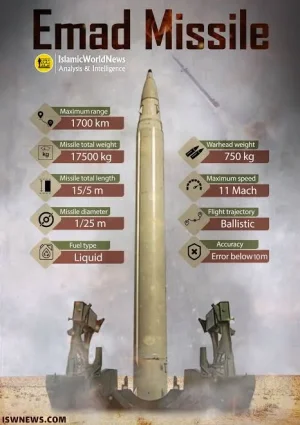There has been a lot of R-R by the usual suspects during the last couple of days after Iran carried out Operation True Promise 2.0.
Almost everyone and his chamcha were vehemently questioning the logic behind the absence of an IRGC styled conventionally armed rocket force in the Indian armed forces.
What these amateur folks don't realise or comprehend is that Iran was FORCED to raise such a rocket force due to the lack of modern 4th gen fighter jets and strike acs. IRGC didn't do it out of luxury or jealousy of the PLA 2nd Artillery corps now renamed as rocket force. Due to international sanctions on Iran after the revolution in 79, IRAF has been unable to buy any new aircrafts. So in absence of a modern air force OR a force armed with 3rd gen acs but having the latest sensors and pods like our Jags, Iran is compelled to raise a potent missile force in order to be able to deliver ordnance on target with relative accuracy and precision over long distances.
Now is this the case with us? Ofcourse not.
Just look at the attacked nation. Israel. How many conventionally armed Jericho IRBM and Popeye ALCM do you think they have? The figure must be in single digit because they have the means to prosecute any ground target far beyond their borders through the application of airpower using manned 4th and 5th gen strike acs.
Now coming to the specifics. Most accounts say that IRGC launched 200 ballistic missiles towards Israel. Some quote this fif as 220. But 181 BM actually managed to fly to Israel.
IRGC used Kheibar Shekan-1/2, Fattah-1 , Emad and Ghadr F/H IRBM in this operation.
Now coming to the maths.
Let's assume that 90 KS-1/2 and Fattah-1 were launched. And the rest 91 were Emad , Ghadr F/H.
View attachment 11059
Kheibar Shekhan 1/2 and Fattah-1 has a max payload of 500 kg. Obviously with this range will be less than 1450 km but let us take 500 kg as mass of ordnance delivered by each of the 90 missiles.
So total payload of 90 missiles = 90*500 = 45000 kg
Now let's come to Ghadr.
View attachment 11060
Ghadr and Emad have been derived from Shahab-3 which itself is derived from Noko No Dong MRBM which in turn is based on Scud F. They are all liquid fuelled.
Max payload is 750 kg. But this will obviously be smaller for max range of 1700 km. Let us take the max payload .
So total ordnance delivered by 91 Ghadr F/H and Emad = 91*750 = 68250 kg.
TOTAL payload delivered to targets in Op True Promise 2.0 by 181 ballistic missiles
= 45000 + 68250 kg
= 113.25 tons.
Now let's come to Bharat.
What will it take to deliver the same mass of firepower in terms of manned air power?
For the purpose of asset preservation, I will be using only standoff munitions.
The easiest way to deliver such a strike with precision exceeding those of the Iranian BM will be to use Su-30MKI armed with LRGB aka Gaurav.
Gaurav has a max range of 100 km when launched from 33000 ft. In ideal conditions when the wind speed is 0, it has a 80+ km range. Weighs 1000 kg. And in terms of explosive content, the fraction is higher compared to BM warheads. Ie per unit kg of LRGB will have more mass of actual explosives be it HMX or Dentex or CL-20 than per unit mass of Fattah-1 and Emad warheads.
Su-30 MKI can carry a max of 5 LRGB. If a MKI carries 5, then 113.25÷5 = 22.65 sorties or 23 sorties will be required.
Now 22 individual Su-30 MKI can be used or 10 Sukhois can conduct multiple sorties(atleast 2) to deliver this ordnance on target.
So what was achieved by 181 BM can be done by only 22 Su-30 MKI each with 5 Gaurav glide bombs.
Now doubting Harry and family will say , but sir 5 ton is too heavy a bombload to be ferried across a range of 1400+ km. So aerial refuellers will be required. Because besides the bombs, AAM and SPJ will be carried by the Sukhois and so weapons payload per aircraft will cross 6.5 tons.
Now let's come to the aerial refueling part .
IL-78M can transfer a max of 105 tons.
At a distance of 1000 km from base, 74 tons of fuel can be transferred. When it's 2000 km, the figure is 56 tons.
If we take the 56 tons figure at 2000 km from home airbase, each IL-78MKI can transfer 6 tons to 9 Su-30MKI. Three refuellers can transfer to 27 Su-30MKI. If the acs are refuelled at 1000 km distance, each IL-78 MKI can refuel 12 acs. So two IL-78mki will suffice.
OR there will be another 23 Su-30MKI which will serve as buddy refuellers and transfer a part of their internal fuel load of 9540 kg or something like that to the attacking Su-30 MK.
Now if we are rise averse and don't want to use a large no of acs and big slow aerial refuellers like IL-78MKI, we can reduce bomb load to 3 Gauravs per Su-30 MKI for a total of 3 ton of ordnance delivered per ac. With a reduced payload, Su-30MKI can cover the required distance without the need for tanker air refuelling.
Besides, 3 LRGB, each MKI will be carrying wingtip mounted ASPJ, 2 R-74 or 2 Asraam , 4 Adder or 4 Astra mk2. The payload per ac in this config won't exceed 5.2 tons.
In this scenario we will need 38 Su-30MKI to deliver the same mass of ordnance on target as the Iranians did with their 181 ballistic missiles.
And each Su-30MKI or for that matter any aircraft can carry out multiple sorties unlike single use BM.
It is for these reasons that most modern nations having access to modern 4, 4++, 5 gen jets and modern pods and sensors from international OEM don't have conventional rocket force. Only Russia and China does. South Korea does have a limited stockpile of Hyumoo series of BM but we too have our Prithvi -1,2,3 and

for conventional strikes.















 for conventional strikes.
for conventional strikes.